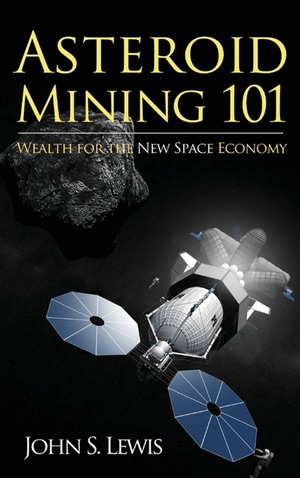Review: Asteroid Mining 101by Jeff Foust
|
| While the title of this book makes it sound like this may be a high-level introduction to the topic of asteroid mining, Lewis quickly dives deep into the details. |
The intersection of those fields—planetary science and commercial space—can be found this week at the annual South by Southwest (SXSW) festival in Austin, Texas. One company with asteroid mining ambitions, Planetary Resources, partnered with NASA on the Asteroid Data Hunter prize competition, the results of which were announced at SXSW on Sunday. Another asteroid mining company, Deep Space Industries (DSI), is also at SXSW, with company CEO Daniel Faber moderating a panel titled “Beyond the Cloud: Big Data in the Off-Planet Era” featuring an eclectic mix of participants.
DSI is also in the book publishing business with the release of Asteroid Mining 101. The book is by John S. Lewis, the planetary scientist and expert on space resources who has previously written on the threat and promise posed by asteroids and comets in the books Rain of Iron and Ice and Mining the Sky in the 1990s. Lewis, a professor emeritus of planetary science at the University of Arizona, is chief scientist of DSI. (The company, which offered media review copies of the book earlier this year, did not provide one when requested by this publication; this review is based on a Kindle ebook version of the book purchased from Amazon.)
While the title of this book makes it sound like this may be a high-level introduction to the topic of asteroid mining, Lewis quickly dives deep into the details. He starts with an overview of the solar system and soon goes into great detail on the various types of both asteroids in space and meteorites that fall to Earth. Much of the book is more “asteroid” than “mining”: it’s not until more than halfway through the book before he starts talking about what resources can be found in asteroids and how to extract them.
Although published by DSI, the book is not wedded to that company’s particular technical architecture: there’s only a brief discussion of DSI’s CubeSat-based spacecraft approach, in a chapter inelegantly wedged between two early chapters on asteroids and meteorites, rather than in the asteroid mining discussion later in the book. Those later asteroid mining chapters focus on what resources can be found in asteroids and the processes and techniques that can be used to extract them, with Lewis emphasizing the considerable differences between terrestrial and asteroidal mining.
| In that intersection of planetary science and commercial space, though, it’s more the former than the latter. |
Lewis also briefly addresses some misconceptions about asteroid mining. “Two fundamental misconceptions about this scheme appear weekly in the press: that we will go into space primarily to mine PGMs [platinum group metals] for shipment to Earth, and that asteroids are a source of Rare Earth Elements,” he writes. Instead, he writes, PGMs are a “lucrative byproduct” of mining for ferrous metals, while rare Earth elements are unlikely to be found in asteroids. It is worth noting that DSI, when it announced its asteroid mining plans two years ago, did itself emphasize PGMs as an eventual, although not initial, market for the company (see “Asteroid mining boom or bubble?”, The Space Review, January 28, 2013).
Overall, Asteroid Mining 101 is a good discussion about the resources that are available in asteroids and how they could one day be extracted. In that intersection of planetary science and commercial space, though, it’s more the former than the latter, including a long appendix going into great detail about the various kinds of meteorites found on Earth. Perhaps DSI will consider an Asteroid Mining 102 book that emphasizes the technologies and commercial prospects for asteroid mining: after all, for this field to transit from the realm of science fiction to reality, you need both science and commerce.
